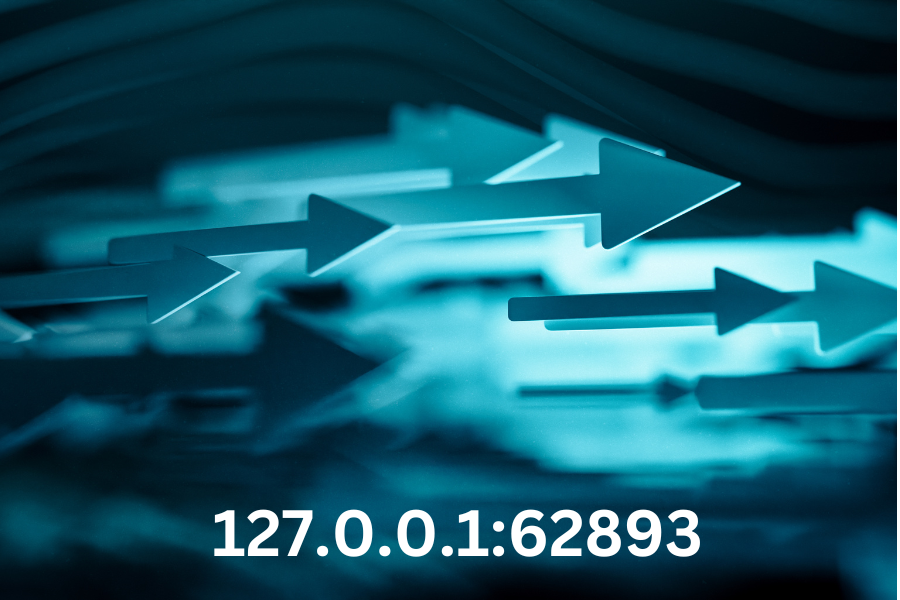Have you ever been using your computer and come across that baffling combination of dots and numbers, 127.0.0.1:62893, while you were just browsing? It’s like coincidentally finding a mystery code in a computer game. But you know what? There’s an entire story behind it, and it’s not simply irregular digits playing surprise on your screen. No, it’s not a typo; rather, it’s an error message of the kind that comes up when you’re working on coding.
Therefore, what’s up with 127.0.0.1:62893? Indeed, we should disentangle the secret together. Picture this: you’re knee-somewhere down in the improvement cycle, coding endlessly, and abruptly, bam! It appears to be trying to convey something significant as it stands there staring back at you. Address, disconnected from the target VM: 127.0.0.1:62893.” It’s as if your computer is attempting to notify you that it has lost connection to a crucial component.
Yet, dread not! This article goes beyond simply decoding technical jargon; Knowing what this sequence means and how to fix it is the key. We’ll discuss the significance of 127.0.0.1:62893, explain what it does, and, most importantly, offer some solutions to deal with the annoying error. Thus, we should make a plunge and demystify this computerized puzzle!
What is the Meaning of 127.0.0.1:62893?
Let’s try to decipher this digital cryptogram, okay?
Our first target is 127.0.0.1. Presently, this lump resembles your PC’s approach to conversing with itself. It is known as “localhost.” Imagine it as a small loopback road in your system where messages immediately return to their starting point. Isn’t that neat?
The numbers 62893 are next on our list. Consider this the entryway number in a clamoring area. This is a kind of gateway called a port number, and it is where various applications knock to send and receive data. It does have its own gig, despite the fact that it is not as well-known as some other ports, such as 80 for the web or 443 for secure connections. Memcached, a clever caching system that speeds up data retrieval, is sometimes connected to it.
Basically, 127.0.0.1:62893 is your computer saying, “Hey, it’s just me, talking to myself, and here’s the door where I’m waiting for messages to come in and out.” It’s a small piece of digital real estate with a special charm all its own.
Discover Further Insights on IP Addresses

Have you ever wondered how your devices navigate the vast internet? IP addresses come into play at that point. They’re similar to the computerized GPS facilitates, directing information parcels to their planned objections.
IP addresses come in two main varieties: Both IPv4 and IPv6 IPv4 addresses are the family’s older siblings, like the familiar 127.0.0.1. However, there is a catch: just like prime real estate in a booming city, they are running out. With its fancy, longer addresses, IPv6 steps in to ensure that more devices can always join the online party.
Let’s now discuss privacy. For local chatter within a network, devices have private IP addresses like 127.0.0.1, just like you have your own private space at home. However, when they want to interact with others, they use their public IP addresses, which enable them to interact with devices located all over the world.
So, the next time you’re on the internet or watching your favorite show on Netflix, keep in mind that these little strings of numbers are what keep everything connected in the digital world.
Explore Deeper into Port Numbers
Imagine that the applications on your device are living on each floor of a busy apartment building. Presently, consider port numbers the condo numbers – they help mail (information bundles) track down their direction to the right entryway.
Imagine this: you’re flipping through channels on your television. Like a port number, each channel takes you to a different show. In a similar vein, each port number on your device is linked to a specific service or application, ensuring that data packets land precisely where they should.
In this way, whether it’s web based music, browsing messages, or video visiting with companions, port numbers discreetly work in the background, guaranteeing a smooth progression of information to the ideal locations on your gadget. They ensure that everything runs smoothly, acting like the digital world’s unsung heroes.
Practical Applications of Localhost
Ah, localhost, the reliable companion of software developers and enthusiasts alike. A glimpse into its amazing world:
Growth on a Local Level: Imagine that you are a programmer working on the next big thing in digital technology.
1: However, you must ensure that your masterpiece is flawless before displaying it to the general public. That’s where localhost steps in, providing a cozy testing area. It’s similar to a virtual sandbox where developers can tweak their creations to make sure they’re polished and ready for the big screen before they hit the internet.
2: Software Exhibits: Have you ever wondered how those impressive software demonstrations look even without an internet connection? Give localhost a try. Providing a platform for showcasing features and functionalities without relying on the unpredictable waves of the internet is the secret sauce that powers the magic. From the convenience of your own device, localhost gives a brand-new app or cutting-edge program the attention it deserves.
So, the next time you run into localhost, keep in mind that it is more than just a string of numbers and dots; Behind the scenes, it is the unsung hero who makes software spectacles shine and development dreams come true.
Tools for Administering Localhost and Ports
With regards to overseeing and watching localhost and port settings, a couple of handy dandy instruments are here to make all the difference:
1: Wireshark: Wireshark is like a digital detective who is always on the lookout for network problems. Wireshark has your back when it comes to troubleshooting irritating connection issues or examining network traffic. With its clever elements, it resembles having x-beam vision for your organization, allowing you to see what’s going on in the background.
2: PortQry: Do you need to look into those enigmatic open ports? PortQry is your best friend. You can query open ports like a pro with this command-line wizard, making it simple to diagnose any issues related to ports. It resembles having an amplifying glass for your ports, giving you a more intensive gander at what’s happening in the engine.
3: Nmap: Have you ever wanted to be network security’s Sherlock Holmes? Nmap is your reliable companion. Discovering what lurks beneath the surface of your network and ensuring its security are the primary objectives of this potent instrument. Nmap has the skills to protect your digital fortress, from scanning networks to finding open ports.
So, these tools are here to help you solve mysteries about the network, figure out problems with ports, or protect your digital domain. You will quickly become the master of your localhost and ports with the assistance of Wireshark, PortQry, and Nmap.
Benefits of Utilizing 127.0.0.1:62893

Utilizing 127.0.0.1:62893 is more than just a random string of numbers; it also has a wealth of advantages for network wizards and developers alike. This is why it is so useful:
1: Advancement and Testing: Imagine yourself in the zone, coding away at your most recent project. With 127.0.0.1:62893, you can test your applications in a comfortable, disconnected bubble. There’s no need to fuss with internet connections or be concerned about snooping. It’s like having your own private laboratory where you can easily eliminate bugs and fine-tune your creations.
2: Networking: At any point needed to look in the engine of how organizations function? Your access to the backstage area is localhost. It’s like getting a crash course in TCP/IP and client-server interaction. You won’t have to worry about getting your head around the fundamentals of networking with 127.0.0.1:62893.
3: Security: It’s important to keep your digital fortress safe, and localhost is your reliable guard dog. By watching out for port action, you can track down any obscure characters attempting to slip into your framework. It’s like having a security camera on your ports to make sure only good people can enter.
4: Debugging: Ok, the delights of troubleshooting – said no engineer of all time. However, you need not be concerned because localhost is here to help. You’ll be able to find troublesome network issues faster than you can say “bug” with its assistance. It’s like having a powerful debugging tool at your disposal, making sure your apps run faster than ever.
5: Isolated Setting: When you have localhost, why would you need drama? 127.0.0.1:62893 makes sure that your applications work well with other applications by creating a cozy little area for development and testing. There will be no more conflicts or problems with compatibility; everything will go as planned.
Thus, whether you’re a coding star or a systems administration novice, 127.0.0.1:62893 is your pass to a universe of improvement delights. With its assistance, you can test, investigate, and secure your applications like a master, all from the solace of your own computerized jungle gym.
Conclusion
In conclusion, as a local loopback address and port combination for application testing and troubleshooting, 127.0.0.1:62893 is essential to software development and networking. Although it provides a controlled and secure environment for development and testing, port 62893 should be exposed to the public internet with caution due to potential security risks.
The risks associated with port 62893 can be mitigated by putting in place appropriate security measures like network segmentation, access control, encryption, and regular updates. Overall, recognizing the significance of 127.0.0.1:62893 and taking measures to protect it can help ensure the integrity and smooth operation of digital systems and networks.
FAQS
1. What is the significance of 127.0.0.1:62893 in networking?
The local loopback address and port combination 127.0.0.1:62893 is frequently used for testing and development. It makes it possible for applications that are running on the same device to communicate with one another without having to connect to a network from the outside. This address is frequently used by developers to test, debug, and troubleshoot applications before deploying them in a controlled environment.
2. How can I determine if port 62893 is in use on my system?
You can utilize different organization demonstrative apparatuses to decide whether port 62893 is being used on your framework. The netstat command, for instance, can be used on Unix/Linux systems to display listening ports and active network connections. Alternately, you can list open files and network connections with the lsof command. The Resource Monitor utility or the netstat command can be utilized on Windows systems to view listening ports and active network connections.
3. Is it safe to expose port 62893 to the public internet?
Due to potential security risks, exposing port 62893 to the public internet is generally not recommended. Unauthorized access, denial-of-service (DoS) attacks, and exploiting vulnerabilities in services running on that port, such as Memcached, are all increased by opening the port to the public. It’s by and large best to confine admittance to port 62893 to confided in clients or frameworks inside your nearby organization to limit security chances.







